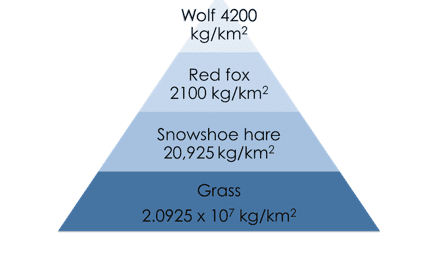In this post
In any ecosystem there is a transfer of energy between organisms. This transfer occurs when one organism eats another. These feeding relationships can be represented in many ways including food chains, food webs, pyramids of number, pyramids of biomass and pyramids of energy transfer.
Trophic levels
Trophic levels show the positions of organisms in these feeding relationships. Each trophic level is given a name:
- Organisms in the first trophic level are known as producers. These are organisms such as algae and green plants which produce their own food and energy using the process of photosynthesis.
- Organisms in the second trophic level are known as primary consumers. These organisms eat the producers and as they only eat the green plants and/or algae, they are known as herbivores.
- Organisms in the third trophic level are known as secondary consumers. These organisms eat the herbivores and as they therefore eat meat, they are known as carnivores.
- Organisms in the fourth trophic level are known as tertiary consumers. These are the organisms which are carnivores which eat other carnivores.
- The decomposers secrete enzymes which are used to break down dead plant and animal matter.

Food chains
Food chains show the positions of organisms in the trophic levels and can be used to identify the organisms which eat each other and look at the transfer of energy which occurs within an ecosystem. Food chains start with the producers. When the primary consumers eat the producers, the energy is transferred from the producers to the primary consumers. When drawing food chains, it is important that this direction of energy flow is clearly shown. The food chains are drawn with the producers first. An arrow is then drawn starting at the producers and pointing towards the primary consumers. Another arrow is then drawn between the primary consumers and the secondary consumers and so on, as can be seen in the following diagram:

For example, a simple food chain where the producer is a rose bush, primary consumers are aphids, blue tits are the secondary consumers and a sparrow hawk is a tertiary consumer, may look like this:

Food webs
In any ecosystem there may be more than one type of primary consumer which feeds on the same producers. This means that it may be possible to draw many food chains for the same ecosystem. These food chains may all be linked as the species involved may be interdependent. This means that if changes occur in the number of one species, all other species are affected. A food web is a diagram used to show how all the food chains are linked and interact with each other, as can be seen in the example here.

Pyramids of number
A pyramid of number is a diagram giving a visual representation of the number of organisms present at each trophic level. The number of organisms found at each of the trophic levels will vary. Usually the number of producers is far larger than the number of secondary or tertiary consumers. The numbers of organisms decrease as you move up through the trophic levels. An example of a pyramid of numbers is shown here.

Pyramids of biomass
A pyramid of biomass is a diagram showing the total mass of all organisms found in each trophic level. When drawing pyramids of biomass, it is important to make sure that each trophic level is drawn to the same scale to give a true representation. The amount of biomass shown in the pyramid of biomass decreases as you move up through the trophic levels.
This decrease in biomass occurs because an organism’s biomass is the total mass of the organism including bone and other parts which are indigestible. As the consumers cannot digest this material, it is passed out as waste and therefore not passed on to the consumer in the next trophic level. An example of a pyramid of biomass is shown in the diagram below.

Energy transfer between trophic levels
The Sun is the source of energy for most living organisms on Earth. The producers in the first trophic level use the Sun’s light energy to make their own food for these life processes. When the primary consumers eat the producers, some energy will be transferred. Further energy transfer occurs when the primary consumers are eaten by the secondary consumers and when the secondary consumers are eaten by the tertiary consumers and so on.
The amount of energy transferred from one trophic level to the next is never 100%. There is always a loss of energy between trophic levels. Scientists have found that as you move up through the trophic levels, less and less energy is transferred and only about 10% of energy is transferred from one trophic level to the next.
This decrease in energy transfer occurs because the organisms at each trophic level use some of the energy for their own life processes such as respiration, movement, reproduction and growth; some energy will be lost as heat to the surroundings; and as you move up through the trophic levels some parts of the organisms are not digestible, meaning that not all the organism is eaten and therefore not all the energy can be passed on. Generally, food chains do not usually have more than four or five trophic levels as there would not be enough energy transferred to provide the organisms with the amount they would need.
Pyramids of energy transfer
A pyramid of energy transfer is a diagram showing how much energy is transferred from one trophic level to the next as shown in the diagram below.


Interested in a Biology GCSE?
We offer the Edexcel GCSE in Biology through our online campus.









